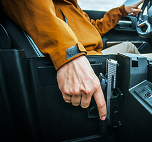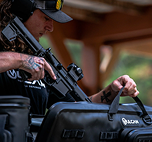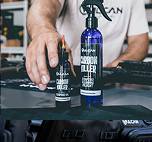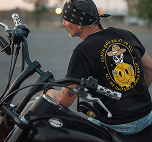If you've ever spent a day at the range or carried your pistol regularly, you've probably noticed how fast grime and buildup start to form. Dust, powder residue, and oil traces settle into every little crevice. It not only looks dirty, but over time it can mess with how your firearm functions. A smooth trigger pull might feel a little sticky, or the action might start lagging. You shouldn’t need to guess whether your pistol will fire cleanly when it matters. Regular cleaning helps keep your firearm running the way it should.
That being said, not all buildup is easy to clean. The tough residue that bakes into your barrel or collects around the firing pin can be frustrating to remove. If you've ever scrubbed the same spot only to find it's still grimy, this is for you. Knowing what kind of residue you’re dealing with is key. Once you’ve got a handle on that, the right tools and solvent can make the rest way less painful.
Understanding the Types of Residue
There’s more than one kind of gunk that shows up on your pistol. Each one clings in a different way and can take a little effort to clean off if it’s been sitting too long. Knowing the difference helps you figure out what to use and where to focus your time.
Here are the common types of residue you're likely to run into:
- Carbon buildup: This is the dark, chalky stuff that usually shows up after firing rounds. It coats areas near the muzzle, slide, and chamber. If left to sit, it dries and hardens, and can eventually make moving parts feel sluggish.
- Lead fouling: If you shoot soft lead or unjacketed bullets, you're probably getting lead buildup inside the barrel. It clings to the grooves in the rifling and can be a pain to clean out.
- Copper fouling: This comes from jacketed bullets and leaves thin metal streaks along the barrel. It sneaks up slowly over time and may affect accuracy down the road.
- Oil and dust mix: Sometimes it's the oil you use that traps fine dust and fibers. This turns into a greasy paste that collects in tight spots around the trigger guard or mag well.
Good cleaning means getting into the tricky corners and handling each type the right way. If you're just wiping down the surface, you're not finishing the job. Built-up residue gets more stubborn the longer it's ignored, so catching it early can save a lot of effort.
Essential Tools for Cleaning Tough Residue
Using the right gear takes frustration off the table. You don’t need a giant box of tools, just a few quality items that are made to clean without causing wear or damage.
Start with this core list:
1. Bore brush – Nylon or brass bristles are solid choices for pushing built-up material loose inside the barrel.
2. Cleaning patches – These help apply solvent and wipe residue clean after scrubbing. You'll go through a bunch in one full session.
3. Patch holder or jag – Makes using patches easier by keeping them firm as they move through the barrel.
4. Toothbrush-style detail brush – Works great for scrubbing tight areas like slides and firing pins.
5. Microfiber rag – Helps clear leftover grime or oil from the gun’s surface without scratching it.
6. Pick or scraper tools – When used right, these can get into those stubborn corners where grime hides.
Optional extras like cotton swabs and bore snakes are helpful too, especially if you want to do a deeper clean every few uses. Above all, avoid super abrasive tools like steel brushes. Clean, don’t scratch. That way, your firearm stays safe while the dirt comes off.
Step-by-Step Cleaning Process
Keeping your pistol in top form is all about doing each step with purpose. Set aside enough time to get through this checklist without rushing. Skipping steps today just means you'll be back at the workbench sooner than you'd like.
1. Prepare your workspace - Clear off a table, add good lighting, and lay everything out so it's easy to reach. A clean space means you won’t misplace small parts along the way.
2. Unload your pistol - This step can never be stressed enough. Take the mag out, rack the slide, and double-check there’s no round in the chamber.
3. Field strip your pistol - Every model is different, so check your pistol manual if needed. Most will break down into slide, barrel, recoil spring, and frame.
4. Apply solvent - Coat the spots where residue is built up and let the solvent sit for a couple of minutes. Give it time to break down the grime. Barrel interiors, bolt faces, and rails are common trouble spots.
5. Brush and scrub - Once the solvent has done its thing, take out your brushes. Use short, back-and-forth motions in the barrel and corners. Don’t press too hard.
6. Wipe down components - Grab your patches or soft rags and start wiping things clean. Change wipes often so you’re not just moving grime around.
7. Reassemble and function check - Dry all parts, re-oil where needed, and put the pistol back together. Then work the slide and check for normal action to make sure everything feels right.
Finish off by taking a last look with a flashlight. Sometimes leftover residue hides just out of sight, and seeing a clean surface gives peace of mind before your next use.
Choosing the Right Pistol Cleaning Solvent
All solvents are not created equal. Some work fast, others are safer for indoor cleaning, and a few handle more than one kind of residue at once. Picking the wrong product can leave buildup behind or even damage internal parts over time.
Look for a pistol cleaning solvent that includes these features:
- Non-toxic and odorless: Keeps your cleaning area safe and pleasant, especially indoors.
- Works on multiple residue types: Something that breaks down both carbon and metal fouling saves time and simplifies your routine.
- Non-corrosive and non-staining: Protects your gun materials and surfaces. Avoid anything that leaves a mess behind or eats away at finishes.
The right solution makes cleaning easier from the start. Choose a solvent that checks these boxes so you’re not stuck scrubbing the same spots over and over. A cleaner that does more in one go helps lock in your effort and keeps your gun running reliably.
Keeping Your Pistol Clean Longer
Once your pistol is spotless, the real work is making sure it stays that way. Good habits go a long way when it comes to stretching time between deep cleans. That means being proactive rather than reactive.
Try these simple maintenance tips:
- Regular cleaning routine: Set a cleaning schedule that matches how often you shoot. If you shoot once a week, aim for weekly cleaning. If it's less, space it out a little more, but still be consistent.
- Proper storage: Store your firearm in a dry place with stable temperatures. A padded case works well, especially one that protects against moisture and debris.
- Post-range inspections: After each shooting session, look for any early signs of buildup. If you see or feel grime near the slide or trigger, give those spots a quick wipe-down.
These small habits save you more time and effort than you'd expect. Preventing the mess before it grows is always easier than scrubbing it all after the fact.
Ready to Clean Your Pistol Like a Pro?
Stubborn residues can be annoying, but they’re no match for the right tools, techniques, and products. Learning how to spot different types of residue, choosing your cleaning gear wisely, and setting up a simple routine can save you a ton of trouble. Every cleaning session makes sure your pistol stays ready for the range, for defense, or wherever you carry it.
Taking care of your firearm shows in its performance. It’s about more than just appearance. It’s about safety, dependability, and keeping things in peak condition. Stick to the system that works, invest in good tools, and trust the right cleaning solvent to finish the job right.
For gun owners looking to streamline their cleaning routine, choosing a reliable pistol cleaning solvent is a smart move. It helps cut through stubborn residue and keeps your firearm running the way it should. Count on VULCAN Arms to provide the products you need to keep your pistol performing at its best.









Share:
When Gun Magnets Stop Working
Strengthening Vehicle Gun Mount Points